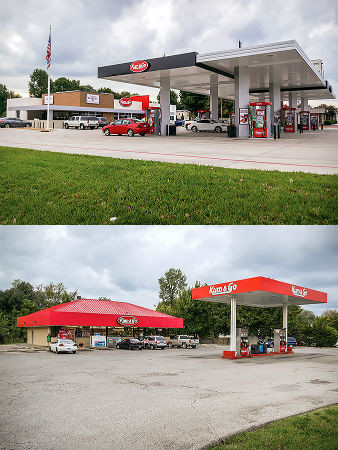
Ronald Leone: New convenience store model is more competitive.
Drive around Springfield and there’s no shortage of new places to fuel up – or eat, charge your phone and shower, usually in the same place.
On West Chestnut Expressway, there’s the newly opened, $6 million Pilot Flying J truck stop, and around town are the makings of some $30 million in new stores and renovations planned by West Des Moines, Iowa-based Kum & Go PC.
Those are only a few of the names contributing locally to a 12-figure, national industry.
According to the National Association of Convenience Stores and Nielsen Convenience Industry Store Count, 154,195 stores accounted for $575 billion in 2015 sales.
Look past the turned earth and fuel canopies being erected, and there’s another change taking place inside the larger walls of the modern convenience store: expanding shelf space to take on more product lines, including fresh foods made in-house.
Ronald Leone, executive director of the Missouri Petroleum Marketers and Convenience Store Association, said the new style that can be seen popping up across St. Louis, Kansas City, Columbia and Springfield is part of a national trend slowly making its way to rural areas.
“It’s our segment of the market deciding that we want to compete more vigorously with grocery stores and drug stores that have tried to compete with us,” said Leone, whose organization counts 320 members representing roughly 75 percent of the state’s gas stations, convenience stores and truck stops. “You’re seeing a blending among the industries and a competition among them that you didn’t see 10 years ago.”
Food and fuel
In addition to more alcoholic and nonalcoholic beverages and snack food options, Leone said there’s a move toward selling fresh and healthier food driven by customer demand. NACS’ most recent State of the Industry report found food service accounted for $61 billion, or roughly 21.2 percent, of in-store sales during 2015.
The push is apparent on the local level. In 2015, Ankeny, Iowa-based Casey’s General Stores Inc. (Nasdaq: CASY) opened a $3 million Ozark store soon after another $2 million project went up in Nixa. In addition to 16 fuel pumps to handle more customers, the inclusion of kitchen space for producing sub sandwiches, breakfast items and pizzas are key components of the new designs.
Casey’s Vice President of Accounting James Pistillo said new store costs run in the $2 million-$3 million range, and the company has a number of growth programs to bring existing stores up to speed. In the last four years, Casey’s implemented the pizza delivery option at some 500 stores and turned 1,000 over to a 24/7 format. Major remodels also tack on sandwich stations, revamped coffee bars and larger coolers – some with walk-in capacity.
“The whole concept of convenience is how fast can I get it and is it the product I want,” Pistillo said.
The food service component isn’t lost on competitors such as Kum & Go, which this year opened two new stores in Springfield and is in the process of building four others, including its first Ozark location.
Newly constructed stores under the company’s prototype, dubbed Marketplace, expand the physical footprint to 6,200 square feet and come in at $4-$5 million in total costs, according to Kum & Go Communications Director Kristie Bell. A Republic store was the third in the chain built in the Marketplace design.
Like Casey’s, the new stores make room for kitchen space alongside extra pumps. New amenities include complimentary Wi-Fi, device charging stations and expanded beer caves at some locations.
“These are bigger stores, so they require more staff,” Bell said, adding the company is planning three more raze and rebuild projects for the Springfield area in 2017. “I would say a conservative estimate is we’re adding at least five new part-time jobs for each store.”
Margin matters
Alongside meeting consumer demand, food sales help gas stations supplant revenues lost to dwindling fuel sales. NACS estimates 5 cents per gallon profits, or less, on gasoline after applying credit and debit card processing fees – the way 78 percent of customers pay for fuel.
Low margins, according to Leone, are the reason standalone gas stations are a thing of the past.
“You cannot have a viable business selling fuel. If that’s all you’re selling, you’re not in business very long,” Leone said. “By and large, other profit centers are available that make the whole business model possible in the marketplace. The fuel is the lever to get them in. The hook is all of the rest.”
Another major competitor, Leone said, is non-MPAC member Tulsa, Oklahoma-based QuikTrip Corp., which has a ubiquitous presence along Interstate 70.
“They make the investment in a location and build a big store with lots of opportunity to fuel and purchase other products,” Leone said. “They seem to be at the cutting edge of any trends making their way in from the coasts.”
Leone notes the trend toward bigger stores and more features is squeezing smaller mom-and-pop operations out of the market. Again, the trend bears out a local example: Last September, Conoco-branded Bair’s Grocery at 5419 S. Campbell Ave. shuttered, and owner Tom Hancock sold the 1.2-acre parcel to Mid-Missouri Bank.
“You may still see those in rural areas, but in more concentrated cities you see fewer because the economies of scale aren’t there for them,” Leone said.
“They can’t survive because of larger competitors. In every industry I can think of, you need to evolve or get out of the business.”
